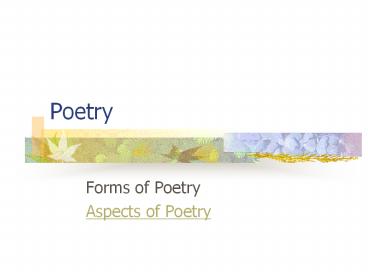Poetry - PowerPoint PPT Presentation
1 / 20
Title:
Poetry
Description:
Ballads, epics, and lays are different kinds of narrative poems. Forms of Poetry - Traditional ... An understatement is the opposite of hyperbole. ... – PowerPoint PPT presentation
Number of Views:161
Avg rating:3.0/5.0
Title: Poetry
1
Poetry
- Forms of Poetry
- Aspects of Poetry
2
Forms of Poetry
- Ballad
- Free Verse
- Lyric
- Narrative
- Traditional
3
Forms of Poetry - Ballad
- Ballad
- A poem that tells a story similar to a folk tale
or legend and often has a repeated refrain. The
Rime of the Ancient Mariner by Samuel Taylor
Coleridge is an example of a ballad.
4
Forms of Poetry Free Verse
- Free Verse
- Poetry composed of either rhymed or unrhymed
lines that have no set meter or rhythm. It is
free of limitations in structure.
5
Forms of Poetry - Lyric
- Lyric
- A poem that may resemble a song in form or style.
Lyrics express the thoughts and feelings of the
poet. Lyrics are usually accompanied by a musical
instrument.
6
Forms of Poetry - Narrative
- Narrative
- A poem that tells a story (The Odyssey by Homer).
Ballads, epics, and lays are different kinds of
narrative poems.
7
Forms of Poetry - Traditional
- Traditional
- A term used to describe all the poetry based on
a regular metre, whether rhymed or not.
8
Aspects of Poetry
- Alliteration
- The repetition of the same or similar sounds at
the beginning of words - What would the world be, once bereft
- Of wet and wildness?
9
- Hyperbole
- A figure of speech in which deliberate
exaggeration is used for emphasis. Many everyday
expressions are examples of hyperbole - tons of money,
- waiting for ages,
- a flood of tears, etc.
- A hyperbole is the opposite of an understatement.
10
- Imagery
- A representation of an object or experience. The
author generally uses imagery to allow you to
experience the image. Images are either literal
words used simply create the picture - or
figurative. Figurative imagery does not follow
the literal meaning of the words exactly. The
most common type of figurative images are
metaphors, similes, and symbols.
11
- Metaphor
- A metaphor is a figure of speech in which two
things are compared to create imagery. Some
examples of metaphors - the world's a stage,
- he was a lion in battle,
- drowning in debt, and
- a sea of troubles.
12
- Metre
- The arrangement of a line of poetry by the number
of syllables and the rhythm of accented (or
stressed) syllables. In short, the rhythm of the
words in the poem. - Some types of Metre
- 1. monometer (1 foot)
- 2. dimeter (2 feet)
- 3. trimeter (3 feet)
- 4. tetrameter (4 feet)
- 5. pentameter (5 feet)
13
- Onomatopoeia
- A figure of speech in which words are used to
imitate sounds. Examples of onomatopoeic words
are buzz, hiss, zing, clippety-clop,
cock-a-doodle-do, pop, splat, thump, and
tick-tock.
14
- Personification A figure of speech in which
nonhuman things or abstract ideas are given human
attributes - the sky is crying,
- dead leaves danced in the wind,
- blind justice.
- Refrain
- A line or group of lines that is repeated
throughout a poem, usually after every stanza.
Similar to a chorus in a song.
15
- Rhyme
- The occurrence of the same or similar sounds at
the end of two or more words. - cat/hat,
- desire/fire,
- observe/deserve,
- pleasure/leisure,
- longing/yearning.
16
- Simile
- A figure of speech in which two things are
compared using the word "like" or "as." An
example of a simile using like occurs in Langston
Hughess poem Harlem - "What happens to a dream deferred?
- Does it dry up
- like a raisin in the sun?"
17
- Stanza
- Two or more lines of poetry that together form
one of the divisions of a poem. The stanzas of a
poem are usually of the same length and follow
the same pattern of meter and rhyme. They can be
compared to paragraphs in poetic form.
18
- Symbol
- Something that suggests or stands for something
else without losing its original meaning.
Examples of symbols are sunshine suggesting
happiness, rain suggesting sorrow, and storm
clouds suggesting despair.
19
- Understatement
- Deliberately underplaying or undervaluing a thing
to create emphasis. An understatement is the
opposite of hyperbole. - My students have shown no poor ability to learn
poetry!
20
- Verse
- A single line of poetry.































